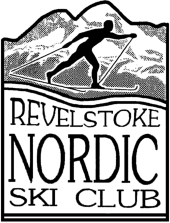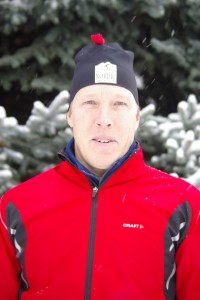Special Interest Articles
These articles have appeared in past club newsletters, in the Revelstoke Times Review, and in other locations.
Table of Contents:
- The New Day Lodge on Mt Macpherson, by Jill Zacharias
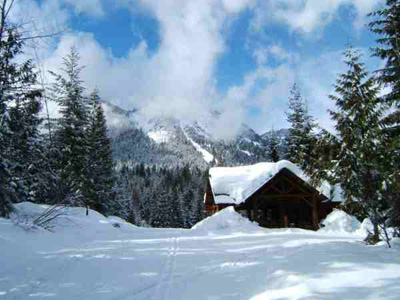
- A Brief History of Skiing in Revelstoke, by Michael Morris
- Long-time service award for trail grooming and other services to the Revelstoke Nordic Ski Club, by Jill Zacharias
- Tips Up: Get in shape for the ski season, from Revelstoke’s Nordic Ski Report, November 1997
- Tips Up: Downhill Thrill, from Revelstoke Nordic Report, from Revelstoke’s Nordic Ski Report, February 1998
- Snow Blindness, by Nordic Natasha, a.k.a. Diana Graham, from Revelstoke’s Nordic Ski Report, March 2004
- Sojourn at Bev’s Bungalow, by Julie Briese, from Revelstoke’s Nordic Ski Report, March 2004
- Waxing Irons: Advice from Nordic Norm, a.k.a Norm Tennant, from Revelstoke’s Nordic Ski Report, December 2004
- Getting a Grip: Advice from Nordic Norm, a.k.a Norm Tennant, from Revelstoke’s Nordic Ski Report, January 2005
- Jackrabbit Youth Program Named for Ski Pioneer, by Michael Morris, from Revelstoke’s Nordic Ski Report, December 2005
- Powder Pioneers – Ski Stories from the Canadian Rockies and Columbia Mountains, a book review by Michael Morris, from Revelstoke’s Nordic Ski Report. March 2006
- Waxing Tip: Removing the sticky stuff, by Michael Morris, from Revelstoke’s Nordic Ski Report, November 2006
- Waxing Tip: Wax your waxless skis, by Michael Morris, from Revelstoke’s Nordic Ski Report, January 2008
- Nature Notes for Mount Macpherson, by Michael Morris, from Revelstoke’s Nordic Ski Report, January 2008
- Who was Mount Macpherson named for? by Michael Morris, from Revelstoke’s Nordic Ski Report, January 2008
- Groomer Brian Abear reports on winter of 2007/08 (includes a chart comparing season length and snow depth for the past 17 years), by Brian Abear, from Revelstoke’s Nordic Ski Report, November 2008
The New Day Lodge On Mt Macpherson
A couple of years ago, Dave Kaegi had a vision. “I saw the need for a day lodge at Mt. Macpherson, so I went to the Nordic Ski Club executive, told them I’d join and see it done.” He smiles. “Course it’s always more work than you think it’ll be. But everybody came through. It wouldn’t have happened without all the support and effort from the club membership and from so many different directions. We raised nearly $450,000 but I bet we’ve had over $800,000 in local contributions and volunteer labour.”
It started with a feasibility study that proposed and priced out a variety of scenarios including the day lodge, custodian residence, maintenance facility, a micro-hydro project which would have supplied electricity, and night-lighting for the Mickey Olsen loop. The membership voted on the options and over 90% said, “go for it all”. Then came the work of rounding up funding and the arduous task of applying for and receiving the license of occupation from the Integrated Land Management Bureau. Kaegi knew this part would require full-time dedication for a while but with the majority of his business taking place during the summer months he knew he could take the time in winter to see it through. “I’m a doer and I had the background for this type of thing. Plus, I’m passionate about it”. Through sheer steadfast perseverance, the license was acquired within a year – a process that usually can take 2 to 5 years.
The club itself laid the first money on the table, in the form of $50,000 cash and the promise of ‘sweat equity’ – volunteer donation of time and labour. This level of commitment proved to be a key leverage point for raising funds. However, despite outstanding fundraising success, Kaegi knew it wouldn’t be enough. The micro-hydro project and lighting a trail for night skiing had to be put on the backburner. The cost of doing the preliminary groundwork for even a small micro-hydro project was prohibitive. As well, the club wanted to build a lodge that would be a testament to Revelstoke’s history, one that would stand the test of time and be a positive reflection on the community.
And the community came through. The first landmark was a complete rendering of the building designs by Glenn O’Reilly – free of charge. For the (incredible!) list of contributions, see below….
When Kaegi’s busy season started up in the spring, Kevin Bollefer stepped up and took the lead on project management. With the exception of the feasibility study, all work by both Kaegi and Bollefer has been volunteer, and when the budget got tight, the call went out to club members to “be part of building the lodge”. Some people spent a day, while others have repeatedly come out to do all manner of work from painting inside to raking gravel outside.
The end result is a modest but well-built day lodge with the custodian residence above, a spacious maintenance facility to house grooming equipment, a stadium track for races, and a terrain park for kids. Club fees remain low, while membership has already hit an all time high. “Now we have the capacity to hold regional races, and the goal within 5 years is to host a BC cup race”, says Kaegi. General estimates are that each regional event would bring about $30,000 into the community. Kaegi says he’ll stay on as president of the club for a little while, then hopes to pass the torch. In the meantime, the club is hosting a big thank you party for all funders and contractors on January 26th from 7 pm to 9 pm. Guess what? Begbie Brewery is providing free beer, Brydon Roe is providing free transportation, and the Modern is contributing food. The generosity of Revelstoke just doesn’t stop.
The Revelstoke Nordic Ski Club thanks the following:
MAJOR FINANCIAL DONORS
Columbia Basin Trust
BC (Resort Municipalities) Tourism Infrastructure Program
CSRD
BC Job Creation Partnership
MINOR FINANCIAL DONORS
Revelstoke Credit Union
BC Ministry of Tourism, Culture and the Arts
Deb Long
CORPORATE & INDIVIDUAL DONATORS OF SUPPLIES & IN-KIND LABOUR
Selkirk Design Works – lodge design Kepex Services- equipment and truck hauling Silvertip Aviation – Fuel donation Sure Haul – equipment hauling donation Alan McInnes – equipment operator Jack Howe – equipment operator MOF Fire Crews – falling timber Revelstoke Septic – septic installation Strong Roofing – roofing Kozek Sawmills Ltd – log purchase & lumber Gorman Bros. Ltd. – spruce lumber Wrights Machine Shop – metal stairs Duguay Contracting – drywall hanging & finish Bhex Contracting – equipment time Green Cat – main floor cabinet construction Revelstoke Builders – building supplies H&J Readymix – concrete and aggregate Battersby Plumbing – plumbing and fixtures Thunderstone Quarries – rock donation Barton Insurance – office furniture Revelstoke Equipment Rental – equipment rental Shuswap Concrete Pumping – concrete pumping J’s Pumps and Plumbing – water pump installation Glacier Building Supply – majority of building supplies Speers Construction – equipment and operator donation Revelstoke Community Forest Corp– supervisory time Downie Timber Ltd. – cedar & fir lumber & equipment donation Selkirk Vinly – Maintenance Shop door installation Wildland Consulting Ltd. – supervisory time Ed Vigue – equipment operator McKenzie Contracting – log hauling Mark DesMazes– equipment operator Vic Van Isle – rebar & rentals Genn Power Contractors – power pole install Ursus Building Corp – equipment time Canyon Electric – electrical and lighting Rough Country Marine – pellet stove Jemb Systems – alarm and low voltage wiring Take it to Heart Contracting – fir post and beams Dankoe Insulating – blow-in insulation Rebel Boom Truck – deliveries Expressive Interior – paint Revelstoke Flooring Ltd.- flooring throughout Phil DesMazes – equipment time TRT Architect Ltd. – architectural services KMR Trucking- equipment and truck hauling Bear Canyon Cabinet Co – upstairs cabinets Wangler Drilling Ltd. – drilled well Ken Gibson and the Ministry of Forest staff Salmon Arm Truss – roof and floor trusses
THANKS TO JOURNEYMAN CARPENTER BOB DICKSON & HIS TEAM
THANKS TO ALL THE EXECUTIVE AND NORDIC CLUB MEMBERS WHO PROVIDED HUNDREDS OF VOLUNTEER HOURS ON THIS PROJECT
A Brief History of Skiing in Revelstoke
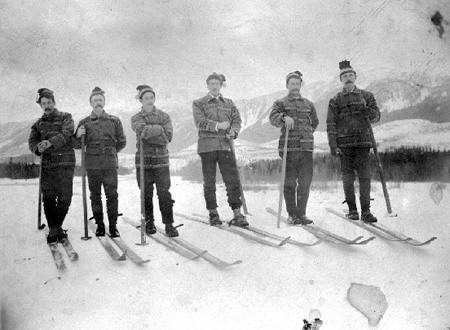 Skiing in this region dates back to sometime before 1890 when Ole Sandberg used a pair of home made skis to descend from his mine to the railway station at Albert Canyon. Sandberg and other Scandinavian immigrants brought skiing to the community both as a sport and as part of their work. Ole Westerberg, for one, used skis to deliver mail 80 kilometres north of Revelstoke, a job he kept for 35 years. Along his mail route he also delivered supplies, ran a trap line, and had misadventures with grizzly bears and thin ice. Revelstoke merchant F. B. Wells was the first to retail skis and alsohelped established the Revelstoke Ski Club in 1891 (the oldest continually operating ski club in Canada). Travel by means of “Norwegian snowshoes,” as skis were initially known, quickly caught on in Revelstoke, a community with one of the highest annual snowfalls in the world.
Skiing in this region dates back to sometime before 1890 when Ole Sandberg used a pair of home made skis to descend from his mine to the railway station at Albert Canyon. Sandberg and other Scandinavian immigrants brought skiing to the community both as a sport and as part of their work. Ole Westerberg, for one, used skis to deliver mail 80 kilometres north of Revelstoke, a job he kept for 35 years. Along his mail route he also delivered supplies, ran a trap line, and had misadventures with grizzly bears and thin ice. Revelstoke merchant F. B. Wells was the first to retail skis and alsohelped established the Revelstoke Ski Club in 1891 (the oldest continually operating ski club in Canada). Travel by means of “Norwegian snowshoes,” as skis were initially known, quickly caught on in Revelstoke, a community with one of the highest annual snowfalls in the world.
Photo: Revelstoke Ski Club 1893 (note matching jackets) – Photo courtesy of B.C. Archives #B000764.
The late 19th century saw a growth of interest in skiing which spread from Norway to central Europe and North America. Ski jumping became a specialized branch of cross country races, which had included leaps from terrain features.
The Revelstoke Ski Club first organized cross-country races and ski jumping events on Mount Revelstoke in 1915, attracting international competitors for the next six decades. In the years prior to the opening of the Trans Canada Highway in 1962, winter access to Revelstoke was only by train. To help accommodate the influx of thousands of visitors to Revelstoke during competitions, extra passenger railcars were left on a siding during the competition as a place for visitors to sleep. 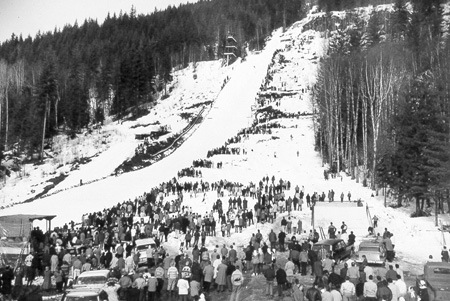
The Mount Revelstoke site, still visible from downtown Revelstoke, was the last of series of jumps built in this area. It was the largest natural ski jump in Canada, and the only site in Canada where world records were ever set. The slope had an ideal shape, requiring little in the way of alteration. The site needed no artificial tower for the jumpers’ approach, and the run-out followed a natural contour. The combination of conditions here made record jumps possible, which is what attracted jumpers and spectators.
Photo: Mount Revelstoke Ski Jump 1950’s – Photo courtesy Revelstoke Museum and Archives.
Flying off the Mount Revelstoke jump in 1916, Nels Nelsen, a Norwegian immigrant to Revelstoke, set a new world record of 186 feet. He held the Canadian record until 1932, breaking his own record five times and setting world records here again in 1921 and 1925.
Nelsen intended to work his way to Europe on a freighter to participate in the 1928 winter Olympics, but team organizers in Britain declined to include him on the Canadian team. More concerned with appearances than performance, they considered his style of travel unbecoming of a gentleman. His ski career ended in 1932 after he lost a hand in an accident with a rifle.
Bob Lynburne did make it to the 1932 Olympics in Lake Placid. Back in Revelstoke the following year he established a world record with a 287 foot jump. A brain injury suffered on a crash landing ended his ski career. He continued to work for the railway but was never quite the same. He had the habit of long walks in the woods and one day he did not return. His body was never found.
Isabel (Pat) Coursier set the world record for women on the Mount Revelstoke jump in 1923 and was the only woman that year to compete unassisted. Other “glider girls,” as they were known, went off the jump holding hands with a male partner. Coursier went on to competitions across North America, often breaking new ground for women’s competitive sport. Her record remained uncontested until her retirement from jumping in 1929. She studied physical education at McGill University and worked as a teacher in Canada and Scotland, returning in her retirement to Revelstoke and later to Penticton.
John McInnes, North American ski jumping champion in 1969, also competed in the Olympics. He continues to operate a business in Revelstoke. His brother Alan McInnes, also a jumper at the time, would take three weeks off work prior to a competition to prepare the jump. The entire slope of snow was first broken with a shovel, boot packed, and then smoothed with skis. Later, a system employing a heavy roller, raised and lowered by a winch, was used for finishing the surface.
The last improvements to the facilities on Mount Revelstoke were made in the early 1960s, which included the judges’ tower that still stands. Lift serviced skiing moved in 1969 from Mount Revelstoke to nearby Mount Mackenzie with the intention of someday expanding to the summit. The last jumping event took place in 1974. The advent of the large constructed jumps nearer to urban centers supplanted to need to travel to remote natural jump sites like Revelstoke. Also, Revelstoke’s heavy snowfalls required a great deal of manual packing—a volunteer workload that was difficult to sustain. Today, the Revelstoke Ski Club continues as an alpine ski racing program. Over the years several local racers have competed internationally.
Cross country skiers split from the parent club to form the Revelstoke Nordic Ski Club in 1989 when the group purchased a track setting machine. The Nordic skiers operate a network of ski trails on Mount Macpherson under an agreement with the British Columbia Forest Service.
Long-time service award for trail grooming and other services to the Revelstoke Nordic Ski Club
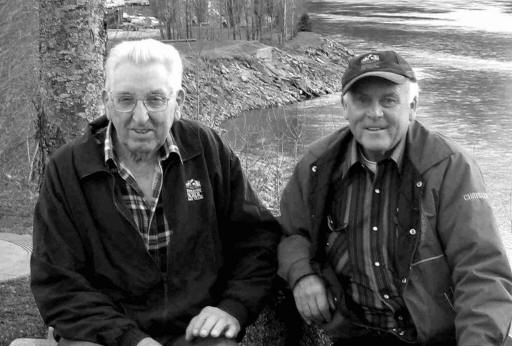 Photo: Mickey Olson, Allan McInnes, Brian Abear (Brian not in photo)
Photo: Mickey Olson, Allan McInnes, Brian Abear (Brian not in photo)
The following article appeared in the May 17, 2008 issue of the Revelstoke Times Review newspaper. It was written by Jill Zacharias as the first in a series of articles featuring Revelstoke’s volunteers.
All across Canada this week, communities are celebrating National Volunteer Week. In Revelstoke, it is the ‘kick-off’ for a year long campaign to promote volunteerism in our community. Revelstoke has a strong history of volunteerism. Volunteers represent one of the strongest threads that tie a community together. In face of the many changes happening in Revelstoke today and in the near future, continuing citizen participation in community organizations and events will help keep our town the friendly, happening place its residents know and love.
The many hundreds of people who enjoy skiing at the Mount Macpherson cross-country area will fully appreciate this month’s ‘Volunteers of the month’ – the men who voluntarily groom those beautiful ski trails – Brian Abear, Allan McInnes and Mickey Olson. What a team!
This winter over 6 meters of snow fell in the Mount Macpherson area. The Nordic ski season had 125 days. The 21 km of trails were groomed 48 times, with a total of 205 hours on the machine. Depending on snowfall, it takes 2.5 to 4 hours to groom the trails each time. Last season (2006/07) had an earlier start. The trails were groomed 56 times with a total of 225 hours. Brian, Al, and Mickey also use the machine to plow the parking lot (3/4 hour) and spend about 150 hours per season doing regular maintenance and safety checks on the groomer itself.
If any trees are blown over the trails, they take care of it. Preparing for the club’s Lantern Ski event is also a team effort, with a few days of preparation for each event. In spring it takes 3 or 4 days of work to put the machine ‘to bed’ for the summer.
As well, every summer, Brian, Al and Mickey (along with other volunteers from the club), spend many hours brushing and widening the trails, falling trees, putting in and cleaning out drainage culverts, and building new roads and ski trails. Often, Al’s wife Evelyn works at his side. This summer there are plans to extend the 3.7 km ‘Mickey Olson’ loop to 5 km, which will allow the club to hold future Nordic ski races.
A couple of years ago, the Nordic ski club collated the number of hours their volunteers contribute. The total was 3000 hours, with the work Brian, Al and Mickey do for the club representing an incredible 2000 of those hours. Whereas Al and Mickey are long-retired, Brian volunteers on days off work and takes his holidays in the winter to enable his contribution.
The three emphasize the cooperation the club has had over the years from the local Ministry of Forests folks and citizens like Gary Schiller and Dan Boltwood who freely offer heavy-duty equipment when needed. The club also gets consistent technical support from Prinoth/Bombardier, from whom they purchased the grooming machine.
All three have a long history of participation in the ski industry and are avid Nordic skiers. Both Allan and Mickey were ski jumpers, spent many hours on Mount Revelstoke, and knew its terrain well. Al remembers cutting the 5 km loop on Mount. Revelstoke with a chainsaw and a couple of buddies. In winter, folks would pack the trail with snowshoes!
Brian has been involved in the development of Nordic skiing in the Revelstoke area since 1978, also when skiing was across the valley on Mount Revelstoke. By this time, the track was set with a snowmobile pulling a tracksetter. It took 5 hours to groom the 5 km loop in this way. Today, Al still uses this system to groom Nordic trails down on the flats and other places around Revelstoke.
In 1983, Revelstoke hosted the BC Winter Games. The high level of volunteerism necessary to host the games took its toll and for a few years afterwards Nordic track-setting was left to individual skiers.
However, enthusiasm renewed around 1988. At that time, Parks Canada was reluctant to widen the 5 km loop to accommodate machine grooming. With the Mount Macpherson area in mind, Brian and a couple other fellow skiers approached Peter Frew, at the Ministry of Forests office, who was very supportive. The old logging roads on Mount Macpherson were perfect for winter ski trails. In the early 1950’s, Mickey worked for Al’s father’s logging company, driving truck and hauling logs out of the Macpherson area. Mickey joined Brian on the trail maintenance team in 1990 and Al in the late 1990’s.
Since the mid-1990’s, the Revelstoke Nordic Ski Club has been able to enhance local Nordic skiing through gradually improving the grooming equipment as well as the hard work and dedication many volunteers like Brian, Al and Mickey. Its membership has gone from around 50 people in the early 1990’s to almost 350 people this season. There is no paid staff. The high level of volunteerism keeps trail fees affordable for all. Brian, Al, and Mickey have learned skills from each other and on the job. Their success stems from love of the sport and their ability to work as a team. A sense of satisfaction comes from making people happy – the smiles and waves they get when they come upon skiers on the trail. Mickey laughs, “you don’t get that in a real job!”
Tips Up: Get in Shape for the season
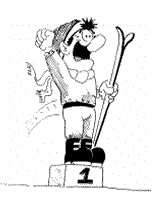 So you have the beginning-of-the-season-feeling-slow-blues and you’re asking: “How can I be in better shape for the ski season?” The answer is pole-walking/running. The next time you hike or run on your favourite trail bring your ski poles along. It will add variety to your off season activities and help get you ready for the ski season. Just using the poles as walking sticks will have some effect, but to really get the most of it, here are some tips:
So you have the beginning-of-the-season-feeling-slow-blues and you’re asking: “How can I be in better shape for the ski season?” The answer is pole-walking/running. The next time you hike or run on your favourite trail bring your ski poles along. It will add variety to your off season activities and help get you ready for the ski season. Just using the poles as walking sticks will have some effect, but to really get the most of it, here are some tips:
- Use poles slightly shorter than your regular classic poles.
- Use old, broken baskets – or they soon will be!
- Walk or run with your poles as you would when skiing. Really think about using your whole upper body to push yourself forward (lean into it).
- Lead with your hips using a long stride to simulate skiing.
- Run on the downhills without poles and “ski walk” with your poles on the uphills to maintain a steady heart rate.
- For those with energy to spare, try bounding up shorter hills using your poles to help you leap from one foot to the next.
Tips Up: Downhill Thrill
Downhill technique is often forgotten as skiers improve their ski technique. In fact, most accomplished skiers find that downhills are the worst part of their skiing. Here are a few tips you can practise to make your downhills faster, more enjoyable, and safer.
- Keep your weight centred over your skis, knees slightly bent and your hands in front of you. This is known as the ‘ready position’.
- When there is a sharp corner on a hill always look through or around the corner 30 or 40 feet ahead of you. This is true whether you are in or out of the track. If you look where you want to go and not right in front of you, your body will take you there.
- When negotiating a tight corner in the track do not lean into the corner. Rather, twist your upper body the opposite way while keeping your hips centred on the track. When done properly you will be able to stay in the track comfortably at higher speeds.
- Try doing a particularly tough hill over and over until you conquer it. Start by doing it at full speed from only part way up the hill. On each successive run go up the hill another 15 feet until you can take it at full speed right from the top.
- For those who are at the stage of doing step turns, remember these four points: be quick and light on your feet; transfer your weight completely from ski to ski as you step; keep your feet close together right under your body; and use your edges.
Snow Blindness: Nordic Natasha’s Newsletter Tip of the Month
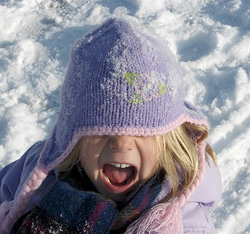 Sunny days are the most enjoyable for skiers. But remember! You must protect your eyes! In the winter, your eyes are exposed to light from above and below when it’s reflected up off the snow. This doubles the intensity of ultraviolet rays. Prolonged exposure can actually burn your eyes and eventually cause snow blindness. Symptoms of snow blindness include pain in the eyes and extreme sensitivity to light. With a good pair of sunglasses you can protect your eyes from both the sun and the wind. Avoid sunglasses with metal frames that are cold against your face. Be sure your lenses have the proper UV protection. For the best protection, choose sunglasses that block UVA and UVB rays between 290 and 400 nanometers (nm).
Sunny days are the most enjoyable for skiers. But remember! You must protect your eyes! In the winter, your eyes are exposed to light from above and below when it’s reflected up off the snow. This doubles the intensity of ultraviolet rays. Prolonged exposure can actually burn your eyes and eventually cause snow blindness. Symptoms of snow blindness include pain in the eyes and extreme sensitivity to light. With a good pair of sunglasses you can protect your eyes from both the sun and the wind. Avoid sunglasses with metal frames that are cold against your face. Be sure your lenses have the proper UV protection. For the best protection, choose sunglasses that block UVA and UVB rays between 290 and 400 nanometers (nm).
Sojourn at Bev’s Bungalo
Looking skyward
To where blue hides
Teasing, creating
Its surprise.
Re-affirming, even unseen
Reality waits
To be embraced, accepted
And then released
Offering one a path to peace.
– Julie Briese
(Note: Bev’s Bungalow refers to the trailhead hut.)
Waxing Irons: Advice from Nordic Norm
Dear Nordic Norm,
Just when you think you have seen it all, along comes something so bizarre you can’t believe your eyes. While in a ski shop the other day I saw an iron, that’s right, an iron, and the price tag was $175.00. What in the world is going on here?
Signed, Steamed
Dear Hot Under the Old Crinkled Collar,
Just imagine if you would have seen an expensive one. The Swix wax iron is around 300 bucks! Here’s the line on wax irons. Most people that actually wax their skis start by using an old regular iron or one of those small travel irons. Like all simple solutions there is a problem. The temperature variation on a regular iron is relatively wide because clothes really don’t seem to care that much. Ski bases, on the other hand, do. Speciality wax irons have a narrower temperature range so in other words it doesn’t change too much. If the iron gets too hot you can seal the base, which changes the structure and slows the skis down. So, do you run out a buy a wax iron? Well, most likely not. Just make sure your regular iron is on a lower setting and make sure the wax doesn’t smoke (nor should you) and keep the iron moving along the base.
Getting a Grip: Advice from Nordic Norm
Dear Nordic Norm,
I told my mother that I was going to write to an advice column and she said why don’t you ask him “why, when it just snowed two feet, do all 12-year-olds still insist on wearing running shoes?”. Anyway that’s not my question. What I really want to know is this: I use my fatter older brother’s old waxable skis and they are okay for length, but I still can’t get grip. Any ideas?
Signed, Bootless in Revelstoke
Dear Soggy Feet,
Well, providing you have reasonable weight shift, here is something to think about. When most people buy equipment for kids and to some extent even themselves, they are more concerned about ski length than the stiffness (camber) of the ski. I myself would rather ski on a pair of skis a bit too long for me than a pair that has too much camber. If the ski is too stiff I can’t flatten the ski when it is time to kick. This means that the wax I took so much time to apply is not in contact with the snow right under my foot, at the point when I need it the most. The result is I have no grip and I backslip. You can not ski if you have no grip and you will not have any fun either.
My advice when buying equipment is that everything should fit properly. That means poles are the right length, boots fit, and skis are both the right length and camber. If you want the skis to last two seasons for someone who is growing, then buy the correctly cambered ski for the first season. If they are soft for the second winter that’s okay; they maybe a bit slower but at least you have had grip for two years.
Now if someone is into racing and they are in their mid-teens and they look like they are headed for the BC ski team, then having a soft slow ski may not be an option. If this is the case I suggest that they make a trip to the local ski store and introduce their parents to the staff. They are going to become good friends in the near future. Remember, don’t let your parents leave home without their VISA card.
Jackrabbit Youth Program Named for Ski Pioneer
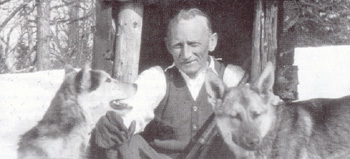 Herman Smith-Johannsen, better known as Jackrabbit Johannsen, was born in Norway in 1875. After graduating as an engineer, he immigrated to the US in 1900 and went to work selling mining equipment in remote places around the world. One such location was in northern Quebec where the native Cree nicknamed him “wapoos” (their word for snowshoe hare) for his speed on snow. They had not seen skis before his arrival. Nor had most North Americans. At some point the name wapoos morphed to Jackrabbit.
Herman Smith-Johannsen, better known as Jackrabbit Johannsen, was born in Norway in 1875. After graduating as an engineer, he immigrated to the US in 1900 and went to work selling mining equipment in remote places around the world. One such location was in northern Quebec where the native Cree nicknamed him “wapoos” (their word for snowshoe hare) for his speed on snow. They had not seen skis before his arrival. Nor had most North Americans. At some point the name wapoos morphed to Jackrabbit.
After the economic collapse of 1929 forced Johannsen out of business, he devoted himself fulltime to the promotion and development of skiing. He oversaw the construction of many trails in Quebec and upstate New York, and even installed North America’s first rope tow near Shawbridge, Quebec. He intended it as a learning device to enable skiers to master downhill technique more quickly. He also built jumps and organized races. However, he is best known for his unflagging promotion of cross country skiing through the 1950s and 1960s, a time when trail skiing had all but disappeared as a winter pastime in North America.
The revival of cross country skiing in North America prompted a flurry of trail development. While I was working on one such project in 1972, Jackrabbit came out to see how we were doing on a trail he had built in the 1930s. He arrived at our camp before we had finished breakfast. His son-in-law supported him by the elbow (he was 97 years old after all) as he spent an hour walking our crude trail. Jackrabbit continued to ski well past his 100th birthday. He passed away in 1987 and is commemorated in the Jackrabbit Ski League, a nation wide program that fosters trail skiing among children.
Powder Pioneers – Ski Stories from the Canadian Rockies and Columbia Mountains
By Chic Scott, Rocky Mountain Books, 240 pages, $29.95
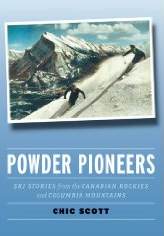 Author Chic Scott is well known for his backcountry skiing guide books and his volume on the history of Canadian mountaineering. Now he has compiled the only book dedicated to the people and stories that outline the development of skiing in the Rocky and Columbia Mountains in all its aspects.
Author Chic Scott is well known for his backcountry skiing guide books and his volume on the history of Canadian mountaineering. Now he has compiled the only book dedicated to the people and stories that outline the development of skiing in the Rocky and Columbia Mountains in all its aspects.
This book goes into detail about the skiing pioneers, who were Scandinavian immigrants who introduced the use of skis, initially for practical purposes, and later for sport. Of particular relevance is the chapter on the ski jumping events on Mount Revelstoke, with vignettes dedicated to local heroes Nels Nelsen, Bob Lymburne, and Isabel Coursier.
The book also includes the how and where the many facets of skiing— cross-county skiing, lift serviced skiing, racing, heli-skiing, ski guiding, avalanche science, mountain rescue, snowboarding, back country lodges— began and grew into what we experience today. These topics are illustrated throughout with many photographs, from the earliest photo of skiing, the Revelstoke Ski Club in 1891, to modern day.
The book’s strength lies with the author’s own area of expertise, long distance backcountry touring. As a member of the small team of skiers who completed the first lengthy icefield traverses from Jasper to Lake Louise and from Mica Creek to Rogers Pass, Scott is eminently qualified to retell these journeys and the ski culture that motivated these epics by people whose accomplishments never made into mainstream media. My favourite is the story of Don Gardener, who in 1991 at the age 45, walked out the door of his Calgary home with his skis and a 10 kilogram pack and arrived at Squamish on the BC coast 28 days later. He travelled solo for 900 kilometres without a tent or stove, sleeping under trees and cooking on twig fires. Now that’s a ski trip!
Waxing Tip: Removing the sticky stuff
Here’s a tip for cleaning off the klister you left on your skis last spring. First, heat up the old wax with a heat gun, propane torch, or hair dryer until the wax is almost liquid. Then place a strip of toilet paper on top of the melted wax. Take a scraper and, starting at one end, scrape off the toilet paper in one smooth motion. The wax will come off easily with the paper. Similarly, old glue can be removed from climbing skins by using an old sheet and a clothing iron. First, tear the sheet into strips, lay a strip on the glue side of the skin and use the iron on the strip. This will lift the glue into the strip. Repeat until the glued surface appears clean. It is not necessary to remove all the old glue, just the dirty, lumpy stuff. Newspaper can be substituted for the sheet but it does not work as well.
Wax your waxless skis
The fish-scale pattern beneath your foot on your “waxless” skis eliminates the need for grip wax when skiing. However, the performance of your stride will be enhanced by applying a glide wax to the smooth parts of the base. Wax as you would a downhill ski using an iron to melt wax, or apply a paste wax, a simpler but less durable product. If your skis are icing on the fish-scales, paste wax will help that too. Rough areas on the smooth part of the base are also prone to icing. Scrape the base smooth with a metal cabinet scraper or fine sand paper. Any ski shop can do this for you, or sell you what you need to do the job at home.
Nature Notes for Mount Macpherson Trails
We share the Mount Macpherson trails with many other creatures. Keeping an eye on the snow, I almost always see tracks of snowshoe hare, marten, and coyote. I frequently see tracks of moose, squirrel, and once, tracks of a wolverine.
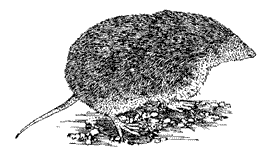 Shrew
Shrew
The smallest track maker is the shrew, the world’s smallest mammal. I would not be able to discern these tiny tracks other than when I get to watch them run along the trail or over my skis. Shrews are dark grey, about the size of a ping pong ball, with a pointy nose. They spend most of the winter under the snow eating insects, larvae, and seeds.
I often see spiders on the snow. Most insects would freeze solid at temperatures below zero, but these particular spiders have the ability to make a glycol-based antifreeze, like that in your car’s radiator, to replace the water that would normally be found in their cells. However, minus four degrees Celsius is their limit. Before the temperature drops to minus four, the spiders return to beneath the snow pack via the openings created by trees. The insulating nature of snow keeps the temperatures at ground level close to zero.
Due to a bumper cone crop this summer, we are being visited this winter by flocks of tree-seed eating birds, mostly redpolls. There was a record number of these birds this year on the local Christmas Bird Count. Before New Year’s Day some flocks seen along our trails had hundreds of individuals. Most of them have moved on now, but you can still see some places where the remaining birds have fed marked by the litter of tree seeds on the snow. Cedar and birch seeds seem the preferred food.
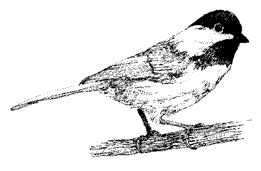 Black-Capped Chickadee
Black-Capped Chickadee
Not as numerous, but with us every year, are the chickadees, nuthatches, and kinglets, which can be heard chirping in the higher branches. They can often be detected if you wait quietly. If you want to be able to identify what you are hearing, the Friends of Mt. Revelstoke and Glacier sell a CD of local bird sounds.
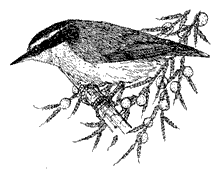 Red-Breasted Nuthatch
Red-Breasted Nuthatch
Again during Christmas week, the ravens were busy vocalizing and flying back and forth from somewhere to the south of the trail system. Likely, there is a carcass that they are eating. A common scenario in a heavy snowfall winter such as this one is that a moose may be walking on the highway at night because its easier traveling . It is struck by a vehicle and then limps a distance into the bush where it perishes from the injury, thus providing a bonanza for scavengers; ravens, jays, coyotes, marten, wolverines, weasels, and other smaller creatures.
Who was Mount Macpherson named for?
Mount Macpherson is named for Sir David Lewis Macpherson (note the spelling). He emigrated from Scotland to Montreal in 1835 when he was 17 years old. He amassed wealth in his family’s shipping business before entering politics. Macpherson was the Minister of the Interior (1883-85) during the peak of construction of the Canadian Pacific Railway. The “interior” at the time meant most of western Canada, as Saskatchewan and Alberta did not yet exist as provinces. His ministry’s lack of understanding of Métis culture and their system of land tenure on the prairies, considered to be the cause of the North West Rebellion of 1885, compelled his resignation from politics.
Groomer Brian Abear reports on winter of 2007/08
In the winter of 2007-08 we had 505 cm of snow fall in Revelstoke – the most snow in more than a dozen years. Yet the length of our season was only slightly longer than average at 125 days. Grooming started December 3, 2007, due to lack of snow in November. At season’s end we had logged 204 hours on the groomer and had groomed the trails 48 times. By comparison the 2006-07 season was our longest on record with 155 skiing days and a record grooming of 56 sessions.
There were only a few breakdowns this season. An oil pressure sender malfunctioned in December and a steering potentiometer failed in February. The potentiometer was replaced at no charge by Prinoth. There were two breakdowns as a result of broken welds on the lift frame and track setters. These were both repaired locally. The club has purchased a diagnostic tool that enables us to read the error codes logged by the onboard computer. While this will not fix a particular problem it will tell us exactly what the fault is and enable us to check the appropriate wiring harness or order the correct parts. At season’s end there were no faults recorded.
The new double walled fuel storage tank was a huge improvement. The tank came with an automatic shutoff nozzle. This enabled the drivers to clean and inspect the groomer while the tank was filling without having to stand over the pump. The pump is powered by a connection to the groomer. The 2200 litre storage tank was filled three times during the winter. There is approximately 1100 litres remaining to start next season. Summer maintenance will include oil and fuel filter changes, torque and brake hub oil changes, complete lubrication and inspection. There is an exhaust leak in the elbow leading to the muffler. This pipe will need to be cut out and replaced. There are also some comb elements on the trailing edge of the tiller that need to be replaced.
The following chart provides an annual comparison of season length at Mount Macpherson and snowfall measured in centimetres at Revelstoke.
| Year | First & Last Track Setting | # of Ski Days | Snowfall (cm) |
| 2007/08 | Dec 3 – April 6 | 125 | 505 |
| 2006/07 | Nov 4 – April 8 | 155 | 465 |
| 2005/06 | Jan 10 – April 1 | 81 | 224 |
| 2004/05 | Nov 25 – Mar 5 | 100 | 221 |
| 2003/04 | Nov 20 – April 3 | 135 | 409 |
| 2002/03 | Dec 28 – Mar 29 | 91 | 198 |
| 2001/02 | Nov 30 – April 9 | 130 | 377 |
| 2000/01 | Nov 26 – April 1 | 126 | 299 |
| 1999/00 | Dec 7 – April 9 | 124 | 330 |
| 1998/99 | Dec 11 – April 4 | 114 | 417 |
| 1997/98 | Dec 20 – Mar 20 | 90 | 231 |
| 1996/97 | Nov 16 – Mar 30 | 134 | 584 |
| 1995/96 | Nov 12 – Mar 31 | 140 | 349 |
| 1994/95 | Nov 20 – Mar 25 | 125 | 263 |
| 1993/94 | Nov 27 – Mar 19 | 112 | 291 |
| 1992/93 | Nov 28 – Mar 19 | 123 | 374 |
| 1991/92 | Nov 29 – Mar 14 | 106 | 344 |
| Average: | 118 | 346 |
